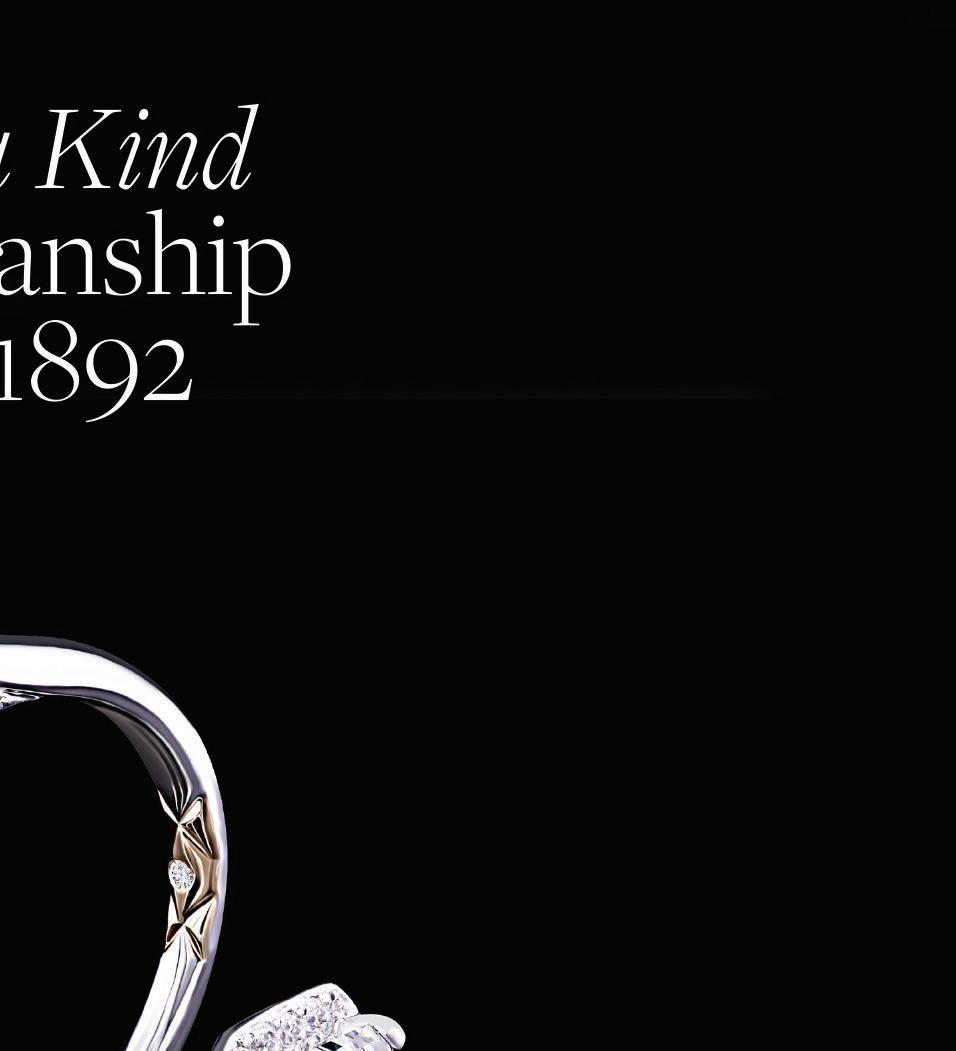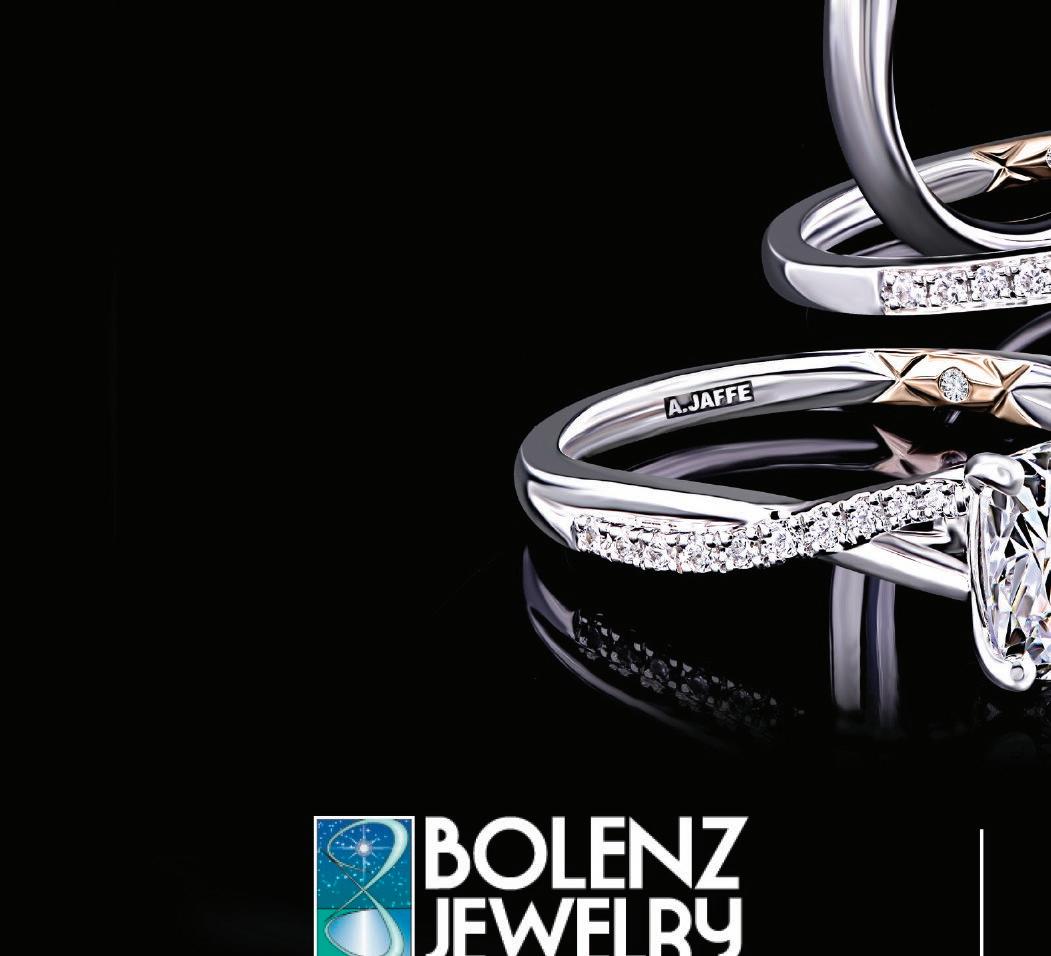BridalGuide2023





HARRISVILLE — She’s got sunshine on a cloudy day.
Rebekah (Maturen) Beardsley married the man of her dreams on Feb. 10, a wedding date pushed up to make sure her father would be there to give her away.
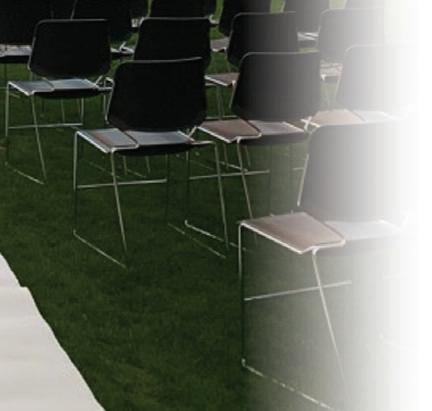
She said they will have a more elaborate celebration and renewal of vows in August, but it meant everything to her to have her dad, Mike Maturen, by her side on her wedding day.

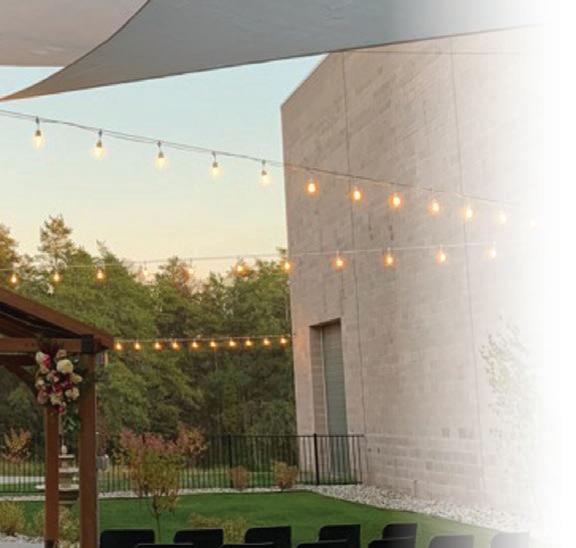
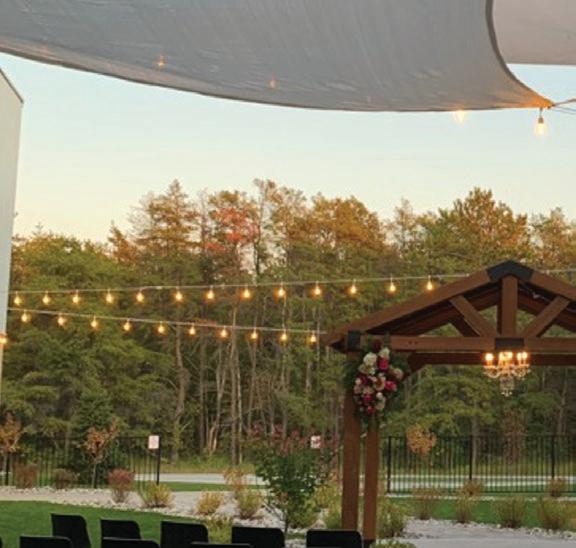
He has been ill, but was able to attend the ceremony at the Alcona County Courthouse in Harrisville and dance with his daughter at the reception, held at the bowling alley, Village Lanes.

The DJ, Ryan Mendyka, played “My Girl,” by the Temptations, which Rebekah said was “the very last song we ever danced to together at a daddy-daughter dance, and I promised him since that day as a little girl that that would be our song.”
Rebekah feels so blessed to have two great men in her life — her father and her loving husband, Andrew.
“He’s got a servant’s heart,” she said of her husband. “As I got to know him more, I just realized his heart is so pure and genuine, and he just cares so much for everybody.”
They have been engaged since April 2021 and have a
9-month-old son, Miles. Rebekah also has a 4-year-old daughter from a previous marriage, Charlotte, whom Andrew has promised to love and protect as his own.
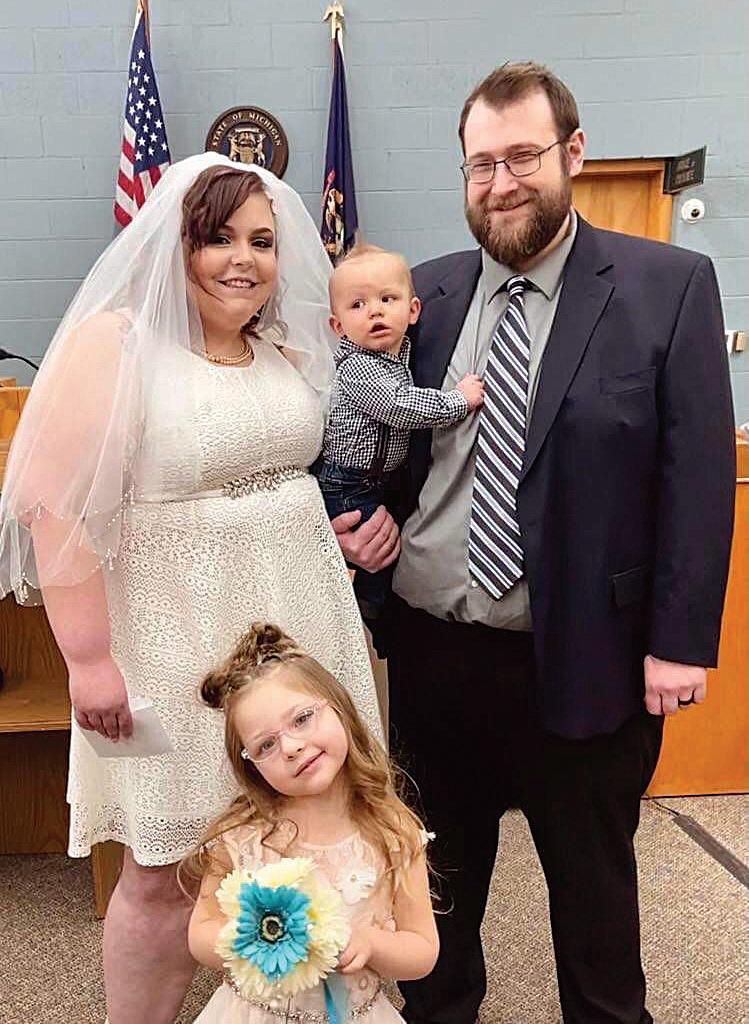
“He requested to write our own vows,” Rebekah said. “And at the very end of his vows, he turned to my daughter and he wrote vows to her. He said, ‘I, Andrew, take you, Charlotte, to be my daughter, from this day forward,’ and I can’t remember the exact wording, but it was very, very sweet. He’s just an amazing human being.”
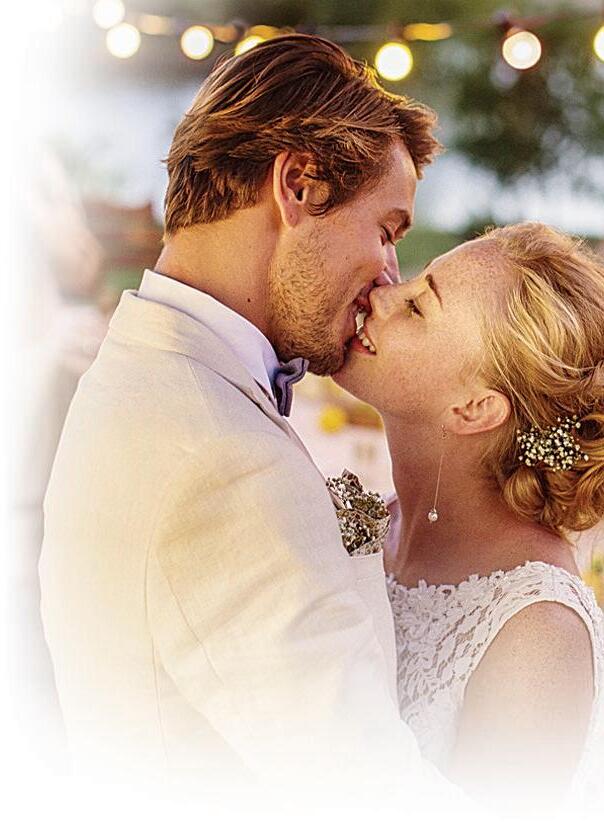
She recalls when she knew she wanted to marry him. His true character showed when he went out of his way to help an elderly stranger.
“I remember this one specific time, we were sitting in the bank drive-through in Oscoda, and this old man had slipped and he fell on the ice, and Andrew jumped out of the car and he went and got him up,” Rebekah said. “And I just remember thinking, ‘That man is the man that I want to marry.’”
Rebekah said it doesn’t matter whether you get married at the courthouse or somewhere fancy, but with whom you decide to spend the rest of your life.
“To me, as long as I’m with him and my kids, I could care less about the finer things,” Rebekah said. “I have him, and I have my children, and that is all I would ever need in life.”
Rebekah’s parents are Mike and Susan Maturen, and Andrew’s parents are Craig and Christine Beardsley.

Courtesy Photos Andrew and Rebekah Beardsley seal their wedding vows with a kiss on Feb. 10 at the Alcona County Courthouse in Harrisville.



A lovely floral centerpiece adorns a table at Rebekah and Andrew Beardsley’s reception on Feb. 10 at Village Lanes in Harrisville.
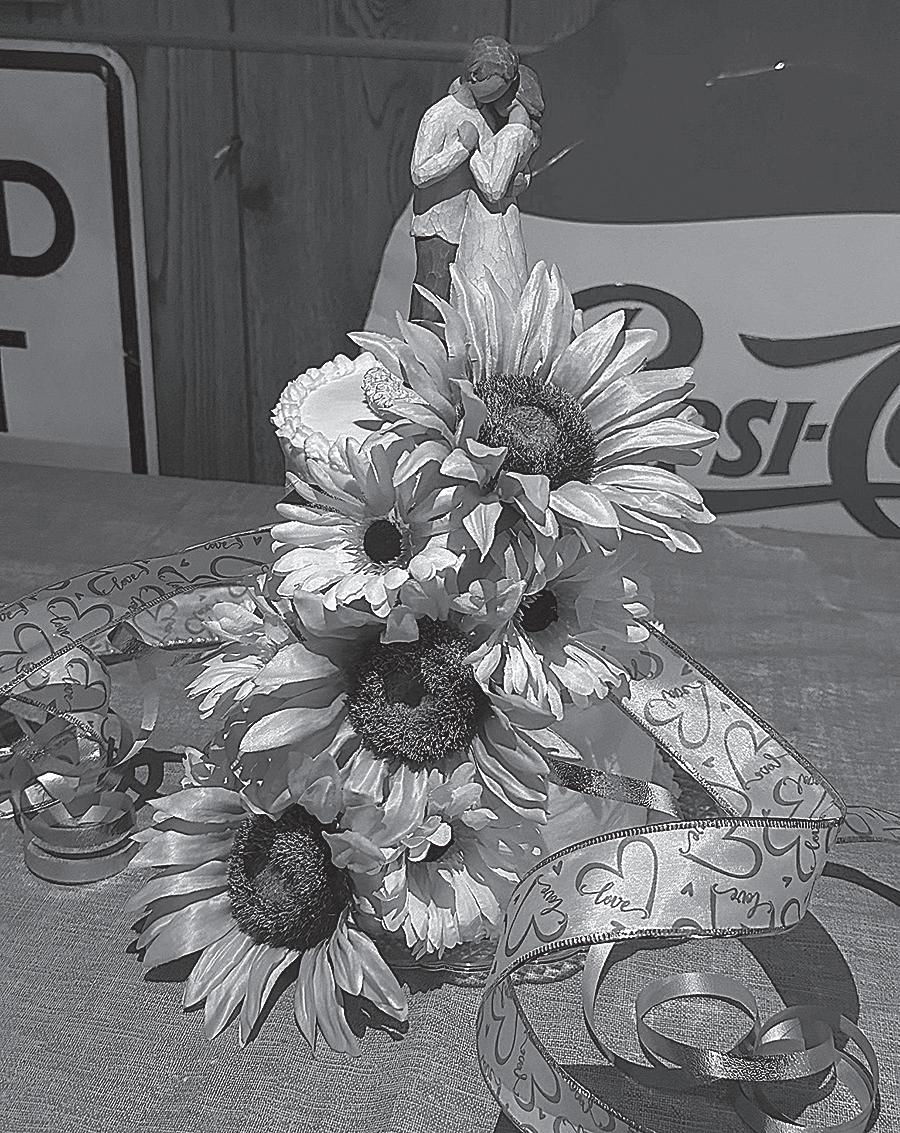

and Andrew Beardsley overlap hands to show off their wedding rings on Feb. 10.
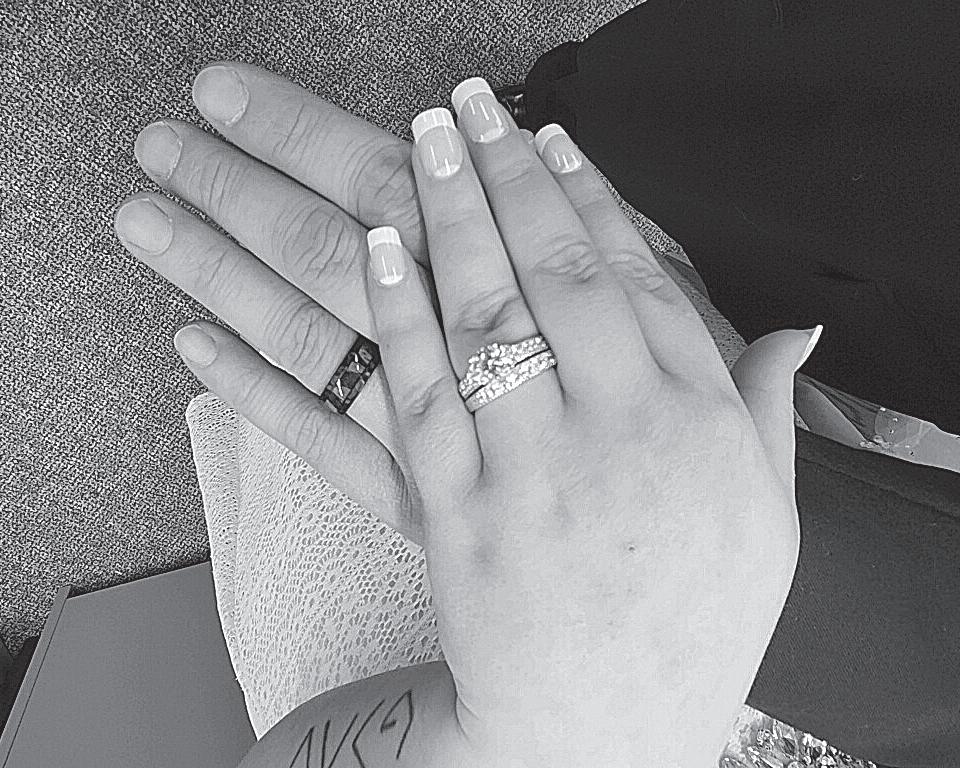


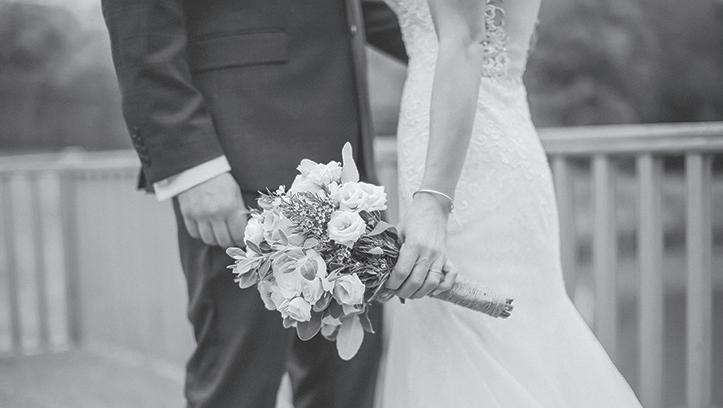
Wedding planning is a unique experience unlike any endeavor most couples will ever encounter. Much effort goes into planning a wedding, and that includes building a budget that ensures the big day will be fun without breaking the bank.
Most couples planning a wedding have never tied the knot before, so it can be difficult to determine a reasonable amount to spend. It’s easy to go overboard when planning a wedding, and couples may find their list of wants and, consequently, their expenses, growing as they get into the weeds of wedding planning. Though it might require some difficult decisions, couples can keep these tips in mind so they can build a wedding budget that won’t land them in debt after saying, “I do.”
• Determine funding. The days when a bride’s parents would finance the wedding entirely on their own are largely a thing of the past. According to a recent WeddingWire Newlywed Report, parents now pay for 52 percent of wedding expenses. As couples begin establishing a wedding budget, it’s imperative that they

first determine who, if anyone, will be helping them finance the big day. Fiftytwo percent of wedding expenses is a significant amount of money, but in that scenario, couples will still need to come up with roughly half of the money needed to fund their weddings. Couples without substantial savings may be forced to cut back in order to avoid beginning their life as a married couple in debt.
• Make a list of potential expenses. Location will be a significant factor when determining potential expenses. For example, a 2022 ValuePenguin analysis of data from The Wedding Report found that the average wedding in Massachusetts cost roughly $30,500 in 2020, while couples

tying the knot in Arkansas spent around $12,500 on their weddings. With such wild fluctuations, it’s important that couples get an accurate estimate of how much it may cost them to get married in a given city. Couples who met in a city and still live in a city but grew up in a suburb might save a considerable sum by getting married in their hometowns. Compare and contrast prices in locales you’re considering, and then build your budget accordingly. This can help you avoid sticker shock and going over budget. Notable expenses to budget include the venue, attire (i.e., wedding dress and tuxedo rental), hairstyle and makeup, entertainment, photography, and transportation, among others.
• Make a list of what’s most important. Most couples will have to compromise in order to avoid taking on debt to finance their weddings. An earnest discussion about what’s most important to each person can ensure you both get what you want. Each person can make a list of their priorities, ranking them from most important to least important. Once lists are shared, couples can see where their priorities converge and where they diverge. Any items that rank low on each person’s list of priorities can be afforded less funding, while those that are high on each list can take up more of the budget, if necessary.
• Commit to a limit before spending a dime. Committing to a limit before spending a dime can help couples keep wedding costs more manageable. Once that number is defined, couples can then work within its parameters, which can make potentially difficult decisions a little easier by narrowing options at a time when options can seem endless.
A well-planned budget can be just what couples need to begin married life on strong financial footing.
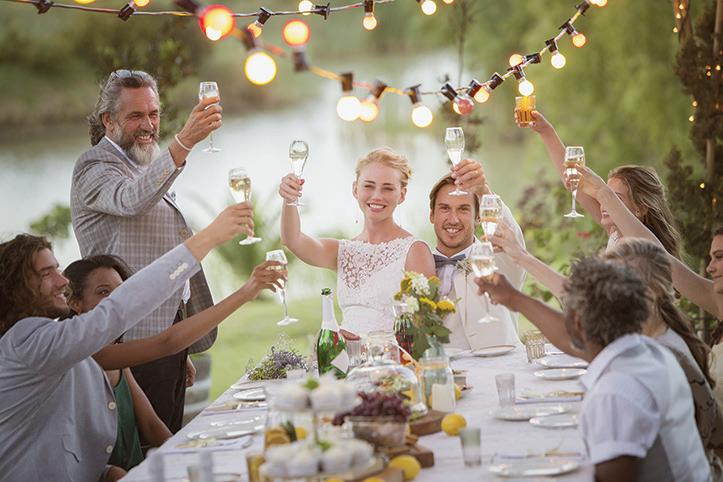
Weddings are such momentous occasions that it’s no wonder couples want to share their big days with as many people as possible. Though a wedding where all friends, family members and acquaintances are in attendance may be a dream scenario, reality often calls for a more carefully curated guest list.
Data from The Wedding Report indicates that the average cost of a wedding is slightly more than $20,000, though that figure could be substantially higher, or even lower, depending on where couples tie the knot. Both The Wedding Report and The Knot report that a wedding venue and catering make up a significant percentage of the overall cost of a wedding, with some figures indicating that these expenses account for around 65 percent of the final price tag. The number of guests couples will host on their wedding day will affect which venue they book and how much food and beverages they’ll need to satisfy guests. Couples who hope to stay within budget can consider these tips as they try to build a guest list that won’t break the bank.
• Accept input. Parents may no longer foot the entire bill for their children’s weddings, but couples who are accepting some financial help from parents must also accept Mom’s and Dad’s input regarding the guest list. Even if parents’ desired guests do not ultimately make the cut, it’s best to respect their wishes and consider who they want to invite. Couples who are financing their own weddings without outside help need not feel beholden to invite anyone who does not meet their invitation criteria.
• Make a preliminary list without regard to budget. Couples can have fun making prelimi-
nary guest lists without considering their budgets. A preliminary list can serve as a solid starting point, and couples may even realize that their list is within budget. Once the preliminary lists have been created, couples can categorize guests (i.e., distant cousins, coworkers, etc.) and then work together to determine if any categories can be eliminated from the invitation list. For example, couples who may be going over budget with their guest lists can each agree to remove distant cousins from their prospective invitees.
• Seek advice. Many couples face difficult decisions regarding their wedding day guest lists, so it can be helpful to speak to a recently married friend or relative to see how they handled paring down their guest lists. Some might have done it by category, while others might have limited guest lists to local friends and family. When taking this approach, couples can speak to friends about how they approached handling people who were surprised that they were not on the final list of invitees.
• Throw a less formal party down the road. A less expensive backyard barbecue within weeks of tying the knot can serve as a less costly alternative to a large wedding reception. Couples who take this approach can keep their wedding day guest lists to a minimum, but invite everyone they hope to see to a post-wedding day backyard barbecue or pot luck picnic so they can celebrate with everyone they love.
Curating a wedding day guest list is no small task. However, couples can try various approaches to keep a guest list more manageable and less expensive.
Weddings are steeped in tradition. Some of those traditions may be exclusive to particular families, but many others are embraced by families of various backgrounds.
Couples needn’t feel beholden to popular wedding traditions, but some may feel that these customs make their weddings more fun and serve as a great way to connect their ceremonies with those of their parents, grandparents and possibly even their ancestors.
The rhyme “something old, something new, something borrowed, something blue” is likely familiar to people about to get married. This traditional rhyme has existed for centuries and refers to items a bride should wear and keep with her on her wedding day. The old alludes to a bride’s past, the new refers to her future, the borrowed is intended to be something borrowed from a married couple or bride, and the blue is a symbol of purity, love and fidelity. These items are traditionally given to the bride-to-be by family members or female friends who are already married.
It’s now up to brides if they want to wear a veil on their wedding day, but it was once a tradition all brides adhered to. Some trace the tradition back to ancient Greece, while others suggest the tradition began in the days of the Roman Empire. Veils were believed to shield brides from evil spirits on her wedding day, thus paving the way for a healthy and happy future. Many brides still wear veils today, though likely due more to their aesthetic appeal than out of a belief that the veil will ward off evil spirits. Some brides still use veils to cover their face as they walk up the aisle, while others flip the veil over their heads.
Perhaps one of the lesser known superstitions surrounding weddings, giving knives as a wedding gift is a no-no for some people. The origins of this superstition are uncertain, but people who abide by this tradition feel that knives are symbolic of a broken relationship. That would likely come as a surprise to the many engaged couples who have a set of knives on their wedding registries.
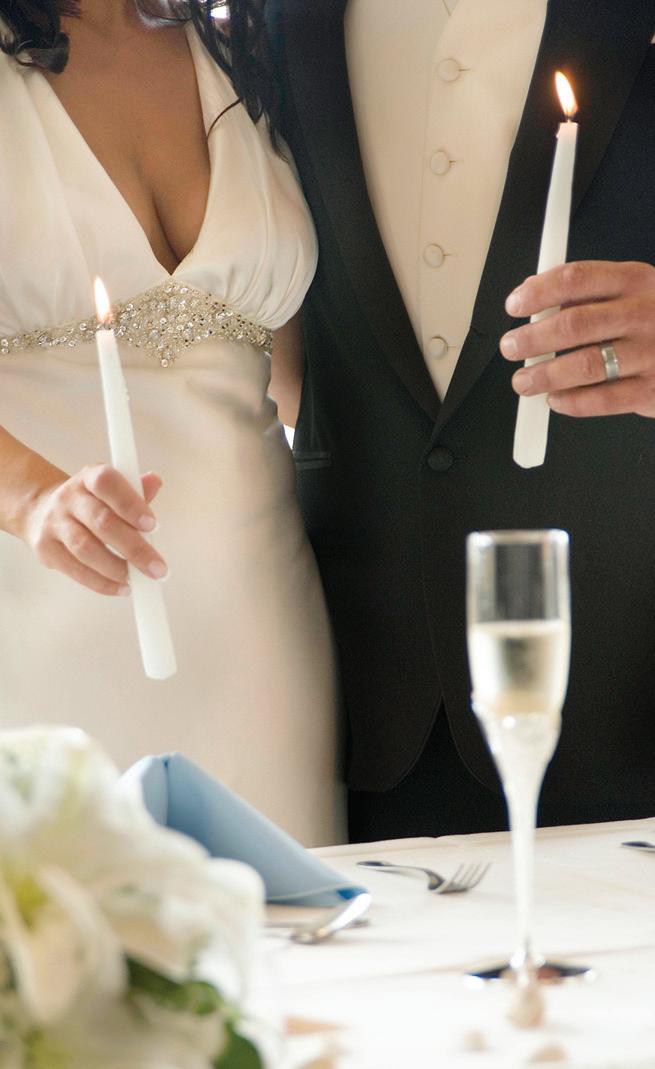
Historians trace this tradition, which Hollywood has undoubtedly helped to keep alive, all the way back to medieval Europe. Also inspired by a bride’s perceived vulnerability to evil spir-
its, the tradition of a groom carrying his bride over the threshold into their new home was believed to keep the spirits form entering the home through the soles of the bride’s feet.
Breaking glass
Couples break glass for different reasons on their wedding days. Within the Jewish faith, one member of the couple will stomp on a carefully wrapped glass to serve as a reminder of the destruction of the Jewish temples and to inspire reflection among those in attendance. Italian newlyweds also may smash glass, but they’ll do it with a little more gusto. Local tradition in Italy dictated that, at the end of the wedding, the newly married couple would smash a wine glass. Folklore suggests that the number of pieces the glass breaks into indicates how many years the couple will stay together.
Lighting a Candle Together
The individual candles represent your individual lives before today. In lighting the centre candle this represents that your two lives are now joined to one light, and represents the joining of your two families, and sets of friends to one.
Tradition is part and parcel of many weddings. Some traditions are more solemn than others, but all can add something meaningful, dramatic and even a little fun to the ceremony.
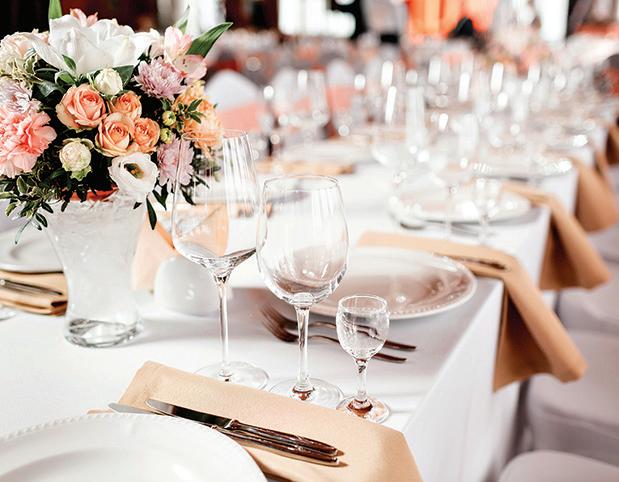
Every decision engaged couples make in regard to their weddings is significant, but some may affect the day more than others. Perhaps no decision will help couples set the tone they hope to establish more than their choice of reception venue.
Reception venues are where couples and their guests will spend the vast majority of their time on the wedding day, which is why choice of venue bears such significance. With that in mind, couples can consider these tips as they look for the perfect place to host their receptions.
• Decide what you want out of a venue. Prospective brides and grooms may have vastly different ideas regarding how they want their weddings to go, and it’s imperative that couples discuss their ideal weddings prior to looking for a venue. Do you want to get married in a place of worship? Or do you prefer a venue that can host both the ceremony and reception? Do you want an indoor, outdoor or hybrid ceremony and reception? Define what you both want before looking for a venue and make the necessary concessions if you have different ideas in mind.
• Consider picking a venue before setting a date. It can be wise to pick a reception venue first and then choose your wedding date based on the availability of the venue. This is especially important for couples who already have an ideal venue in mind, and it also provides some flexibility as couples search for the venue. For example, couples working within a



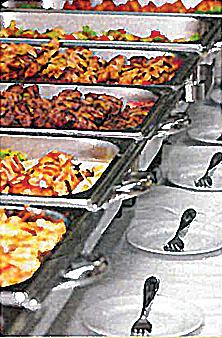
strict budget may not be able to afford a preferred venue during the height of wedding season, but that venue could be less costly during slower times of year. By waiting to pick a date until you’ve chosen a venue, you’re increasing your options.
• Consider your guests. Though couples, particularly those footing the bill on their own, should prioritize their desires when choosing a reception, it’s important they also consider their guests before making a final decision. A venue that’s accessible and located near transit hubs like airports and train stations will increase the likelihood that more people can attend. In addition, if children will be invited, a venue that includes family restrooms, including at least one with a changing table, can make parents’ nights much easier.
• Consider your budget. The Knot 2021 Real Weddings Study found that couples typically spend around 30 percent of their overall budget on the venue, which makes this decision the biggest one in terms of the financial commitments a couple will have to make. Couples may be tempted to choose an awe-inspiring, costly venue for their reception, but they should consider how devoting so much of their budget to the venue will affect the rest of their big day. The best reception venue might be one that won’t eat up too much of your budget.
• Consider the package. Venues vary in terms of their reception packages. Some may offer catering, including bever-
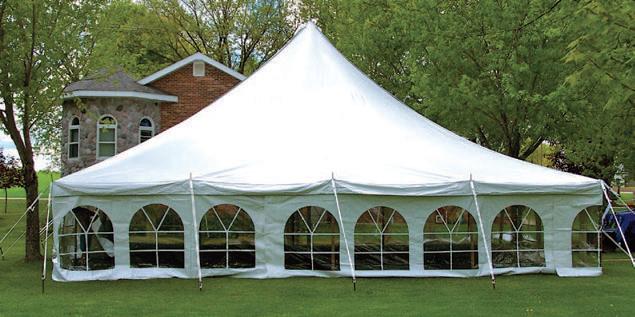

ages, with each of their packages, while food and beverage might not be part of other venues’ offerings. If you find a venue you love but it doesn’t offer catering services, seek estimates from area caterers to determine how much it will cost to feed and serve your guests. Many couples find it more convenient and less stressful to pick a venue that offers on-site catering, though plenty of others have had no trouble after choosing a venue and separate caterer.
The bulk of a couple’s wedding day and night will be spent at the reception, making choice of venue one of the more fun and important decisions they’ll have to make.


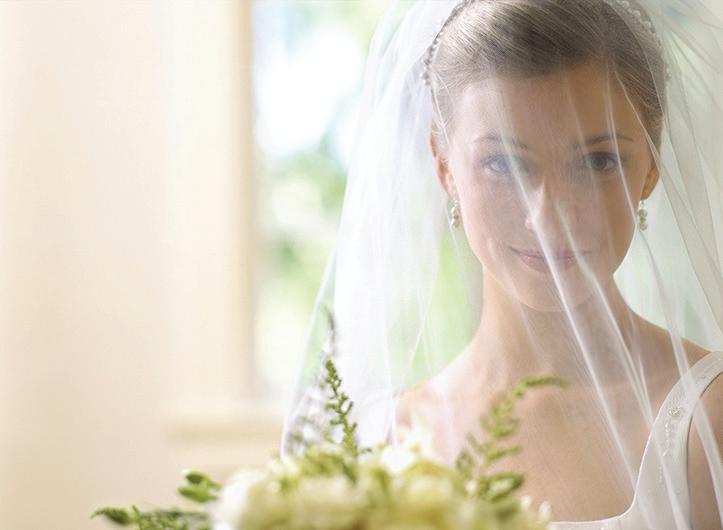
Though couples can plan wedding ceremonies and receptions how they see fit, many weddings are steeped in tradition, some of which may be more subtle than others. One longstanding wedding tradition revolves around a bride’s attire. Historians differ regarding the origins of the bridal veil, but some trace this tradition all the way back to Ancient Greece. Others suggest bridal veils were first popularized within the Roman Empire by people who believed that the veil protected the bride from evil spirits as she walked down the aisle. Traditions surrounding bridal veils even differ within various faiths, so the veil may signify one thing at a Jewish wedding and something entirely different at a Christian ceremony. Veils also have long been seen by some as symbolic of purity. Despite their long-held position in wedding lore and tradition, veils are no longer seen as a must-have. Nor are brides who choose to wear a veil beholden to having it cover their face as they walk down the aisle. In fact, many modern brides now flip their veils over their head as they walk down

the aisle en route to saying, “I do.” Regardless of how brides who opt for veils choose to wear them, there’s no denying the enduring popularity of this tradition.

Participating in a wedding party is an honor. Couples invite many people to their weddings, and the select few asked to be in the party are typically those individuals with whom the couples shares a strong and special bond.
The role of the wedding party is not merely symbolic. Though it’s up to the happy couple to determine how involved they want their wedding party to be, individuals asked to be in the party should know that their acceptance of these roles carries with it a certain level of responsibility.



The maid of honor may bear the most responsibility of any wedding party member. Maids of honor typically help with the planning of the wedding, offering advice and opinions on everything from the bride’s gown to the bridesmaid dresses and anything else a couple might need help with. If the bride asks, the maid of honor may be asked to organize dress fittings and attend them as well. A maid of honor typically plays an active, and often the lead, role in planning the bachelorette party. Come the day of the wedding, the maid of honor helps the bride prepare and may organize the bridesmaids to ensure everyone stays on schedule. A maid of honor typically toasts the happy couple during the reception as well.
Like the maid of honor, the best man has some extra responsibilities before the wedding and during the festivities. A best man may organize tux fittings, plan the bachelor party, help make arrangements if the groom requests help, and be asked to hold the rings on the day of the ceremony. A best man toast is common during the reception, and some grooms ask their best men to distribute tips to vendors at the end of the night.
Bridesmaids often help the maid of honor plan the bachelorette party, and they also
help to organize the bridal shower if the bride chooses to have one. Bridesmaids can offer input on wedding planning, particularly if they’re already married, though that is not necessarily required. Bridesmaids also can help relieve stress on the bride by being as agreeable as possible when scheduling dress fittings.
Groomsmen help to plan the bachelor party and may be asked to provide some support prior to the ceremony. For example, on the day of the wedding, groomsmen may be asked to show guests, particularly elderly friends and family of the couple, to their seats. Like their bridesmaid counterparts, groomsmen can be especially helpful by doing what’s asked
of them without resistance. Arriving on time to tuxedo fittings and offering insight when they think it might help are some simple ways groomsmen can pitch in.

Often reserved for children, the roles of flower girls and ring bearers only require some simple participation during the ceremony. Flower girls drop petals as they precede down the aisle ahead of the wedding party, while the ringer bearer carries the ring down the aisle. If these roles will be filled by especially young children, couples may choose to have them walk down the aisle together.
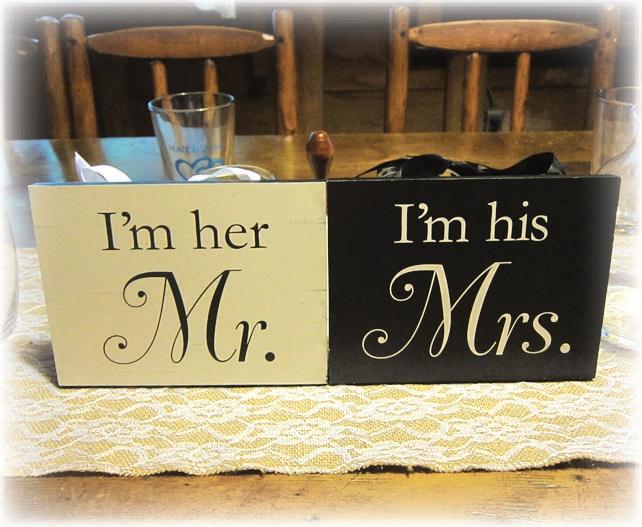
Parents of the bride and groom typically play supportive roles but may be asked to give speeches during the rehearsal dinner or the reception. The father of the bride typically walks her down the aisle, while the mother will likely spend the day of the ceremony at the bride’s side as they get ready. Parents of the groom do not have any traditional responsibilities, though the groom and his mother customarily share a mother/son dance during the reception.
Couples need not feel compelled to assign bridal party members these duties if they don’t feel comfortable doing so. However, sharing some of the responsibilities of wedding planning can help couples enjoy the process more and keep party members engaged.


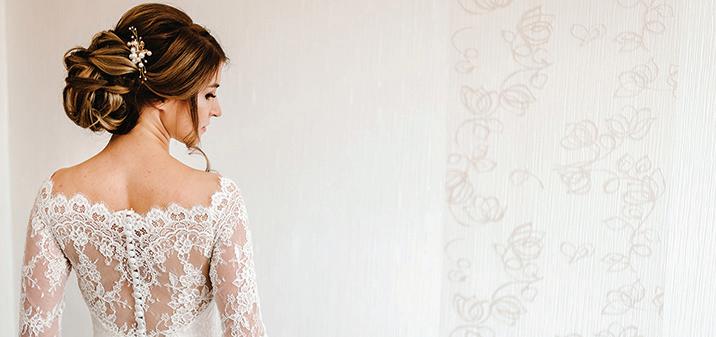
Planning a wedding requires making many different decisions. The choice of wedding attire is among the most crucial decisions that couples must make. Whether the wedding is traditional or customized to suit couples’ personalities, brides and grooms want to look their best when they say, “I do.”
Many brides-to-be spend a significant amount of time looking for their ideal wedding dresses. What defines the right gown depends on personal preference and is unique to the person doing the search. For example, a dress that sets a fairy tale scene for one bride may not necessarily align with the tastes of another. According to Bridal Atelier, the average bride-to-be tries on try three to seven dresses before finding the right one. The following tips can help those shopping for dresses find a look that makes their big day even more special.
1. Don’t get hung up on perfection
Many brides get caught up as they search for the one dress they consider perfect. No dress is likely to check every box. Getting hung up on a desire to find a dress that has it all may make it hard to see the beauty in other dresses. Remember, with the talents of an experienced tailor or seamstress, most dresses can be tweaked to suit your vision of the ideal gown.
2. Consider the season





Getting married during the hazy and humid days of summer is an entirely different experience than tying the knot during the heart of winter. The fabric of the wedding dress should complement the season, whether it’s lightweight and breezy for a warm day, or more substantial and cozy when darting to the ceremony in snowfall.
3. Flatter your figure

Chances are brides-to-be know which cuts and styles are most flattering. Mimic those style choices in the wedding dress. If you want to take focus off of full hips, choose a basque or asymmetrical waistline. Gowns with substantial straps or higher necklines may be better if you have a larger chest. Sheath and mermaid style gowns are options if you are confident with your figure and want to show off your curves.
4. Try a bit of this and that
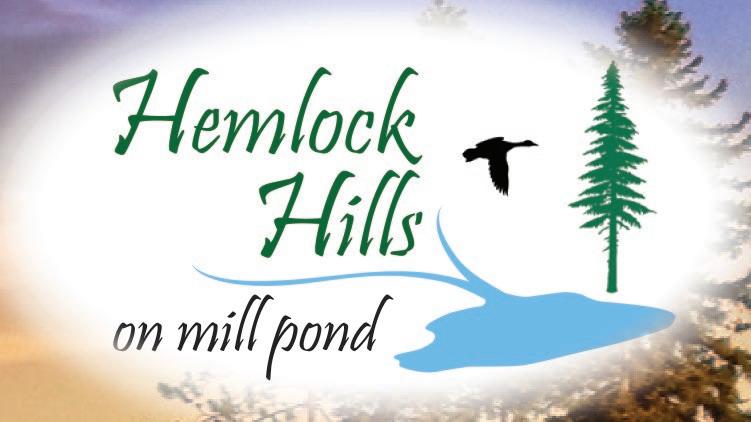


Don’t go into a wedding dress appointment with firm parameters. Although you may have a ball gown style in mind, after trying on other options something with a less voluminous silhouette may actually catch your eye. Many brides also automatically defer to strapless gowns, when various straps and sleeves can be very appealing.
5. Arrive with a firm budget

Weddings can be costly. It’s important to set a budget for the wedding dress just as you will with other expenses. There are plenty of dress designers across a wide spectrum of price points. A willingness to consider and ultimately purchase a less costly dress can help you stay on budget.
Browsing through magazines and looking online can provide wedding dress inspiration as well. Also, when in doubt, defer to the experts at bridal shops who have experience choosing dresses that brides are inclined to love.
Various elements come together to complete a wedding day visual. Floral arrangements are one such component that can create a special and awe-inspiring ambiance.
Flowers appeal to at least three of the senses. Their delicate aroma can help a venue smell fresh and inviting. And it’s hard to deny the visual appeal of a stunning floral arrangement. There are colors, sizes, textures, and much more that can cater to any theme. In addition, flowers can add a tactile element, even if guests do not going around touching the blooms. Flowers convey so much during weddings that it’s important to make finding a florist a priority, according to the wedding resource The Knot. The following is a guide to understanding floral arrangements that may be included in a wedding.
The wedding party, bride, groom, and parents of the couple are set apart from others at the wedding ceremony by the special flowers on their attire and in their hands, among other indicators. Boutonnieres are a single bud pinned to the left side of a gentleman’s jacket. Corsages can be attached to a dress, but are now often worn on the wrist. Bouquets are held in hand. They can be a few flowers gathered together, or more extensive displays. Bouquets may feature bare stems, or stems may be bound and hidden beneath ribbon and fabric.
Some couples also have a small tossing bouquet to use later in the day. Flower petals for a flower girl to drop down the aisle also may be part of the floral plan.
Guests often are first introduced to floral arrangements at the wedding ceremony. Potted or vase-encased flowers may bookend the couple at the altar. Seats or pews may be adorned with flower sprays to draw attention to the aisle, known as aisle markers. These are subtle choices that enhance the ceremony space.
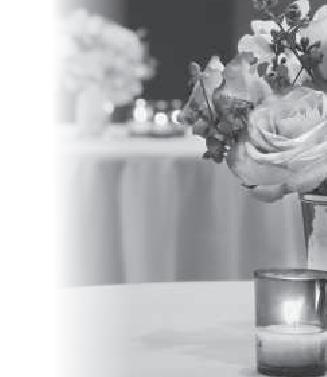
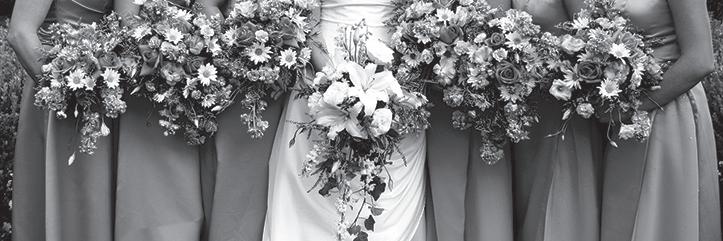



Flowers may truly shine during the reception. They’re one of the most important components when decorating the space. Flowers serve as centerpieces, so the guest list and the number of tables will dictate how many centerpieces are required. These centerpieces can be elaborate or simply a few loose flowers in vases. Florists can customize the look depending on couples’ budgets. Some additional reception flow-
Nerves are to be expected when getting married. It is exciting to be engaged and realize you have met that special someone with whom you want to share the rest of your life. But anxiety may creep in as the big day draws closer.
A lot of planning goes into a wedding, and often the pressure that comes with trying to create the perfect day can overshadow feelings of love and excitement. That is when wedding jitters may crop up. Couples must recognize they’re not alone if they feel a little uneasy as their wedding day draws closer. However, there are ways you can address and tame jitters both before and during the wedding.
Step away from wedding-related tasks
Chances are you have spent months with the wedding on your brain. In fact, it likely has consumed your daily life. Take a day or two to do something unrelated to the wedding, whether you’re alone, with friends or with your future spouse. Attend a fun event, go out to dinner, queue up several movies for a night in, or take a small trip. Keep wedding details out of the picture while you’re enjoying yourself.
Forget about being perfect Wedding jitters often stem from being nervous about everything going to plan. You may put undue pressure on yourself to ensure everything is perfect. But perfection is impossible, and the sooner you accept that a thing or two will likely not work out, the less stressed you may feel. You’ll be surrounded by family and friends who will help you roll with the punches, whether that’s a torn hemline or a missing buffet item. Guests are here to celebrate you, not pass judgment.




Some couples feel jittery because they haven’t spoken about all of the changes ahead. These can include relocation, merging of finances and whether or not children are in your future, among other things. Stress can be tamed if you take a break from wedding planning and discuss these important topics.
Learning to relax is important when dealing with anxiety. There are many different relaxation techniques to explore. Some include meditation, yoga, deep-tissue massage, exercise, or immers-
ing yourself in a peaceful spot outdoors. Some people turn to reading or other hobbies to relax. Do not look to alcohol or medication as an outlet to alleviate stress.

If anxiety about the wedding is eating you up, consider speaking with a professional therapist or
ers can include installations on arches or on anything hanging like a floral backdrop for photo opportunities.
Couples should create a list of everywhere they would like to use flowers and present it, along with magazine clippings or planning boards, to show florists what they have in mind when shopping services, according to Hummingbird Wedding Advice. A 2021 survey from The Knot reported that the average cost for wedding flowers was $2,300. It’s important to set a strict budget so florists can present ideas that are in line with what couples can spend. Many expensive looks can be replicated with in-season flowers or less costly alternatives.
Flowers are an important part of the wedding day and should be incorporated into couples’ budgets.
even a close friend or family member. Sometimes a new perspective is all you need to calm the jitters.
Nervousness when planning a wedding is understandable. However, couples can take steps to tame jitters so they enjoy all that goes into tying the knot.
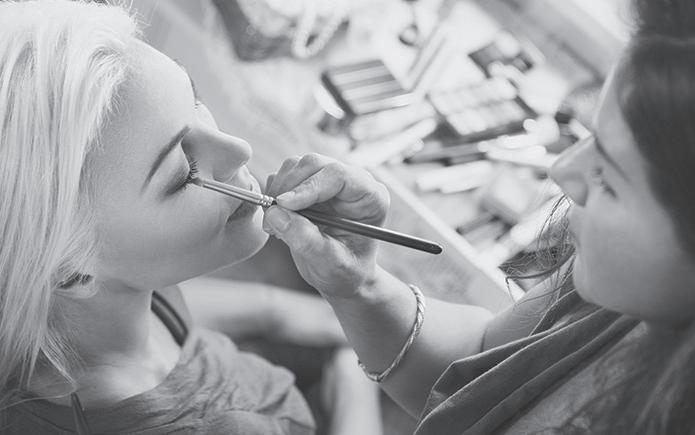
A wedding gives couples a chance to shine and celebrate their love for one another. Naturally, all eyes are on the happy couple on their wedding day, and that means brides and grooms want to look their best. For those planning to wear makeup, relying on a skilled makeup artist can make a big difference in how couples look in videos and photographs.
Professional makeup artists will be acquainted with techniques that can enhance individuals’ looks on their wedding day. Makeup artists recognize which products to use to ensure a flawless face lasts all day. This person also can take the pressure off the bride having to do makeup herself, meaning the bride can sit back and relax for a half hour or more and enjoy being pampered. Techniques like lash applications, contouring and highlighting require skill, and skilled makeup professionals are well-trained in these areas.
When shopping around for makeup artists, couples with limited knowledge of what to expect can look for certain factors to help them make the most informed decision.
There may be a stark difference between cosmetics and beauty products purchased at the drug store and the professional-grade items used by makeup artists. Professional products have been engineered for specific applications. They tend to be long-wearing and luxurious. Look for a makeup artist who uses top-notch brands.
A bride’s vision and the makeup artist’s vision may not be one and the same. Only after a
trial application can you determine if the makeup artist is able to deliver the look you desire. It’s important for a bride-to-be to go to the trial appointment with an open mind and reserve judgment until the application is complete. A professional can make suggestions on a color palette and products that will complement skin tone and needs.
Many brides desire natural looks on their wedding days, but fail to understand that this is one of the most photographed moments in their lives. High-definition cameras and lighting can affect how makeup appears in film and in photographs, as well as what a complexion and pores will look like. Taking photos during the trial appointment will help you see what you will look like in pictures, which may be different from how makeup appears when looking in the mirror. Chances are a bride will need to be much more made up than she thinks when asking for natural. A qualified artist can strike a balance between natural and photo-ready.
Some makeup artists are willing to be available for a short time before the start of the reception. This gives them the opportunity to touch-up makeup if needed after the ceremony when most of the posed photos are taken. Also, adjustments can be made at this time if a bride wants a “nighttime” look.
A makeup artist can help couples look their best during their weddings, making them a worthy investment of time and money.
After a formal wedding ceremony, complete with processionals and “I dos,” comes the part of a wedding that enables the happy couple to brush off the last vestiges of jitters and celebrate. A wedding reception marks the culmination of months or even years of planning. Oftentimes a hundred guests or more gather to dine, dance and toast to the prosperity of the newlyweds.
Certain components of a reception will prove more memorable than others. Food is one such element. The other component that tends to make a lasting impression is the music, which means couples curating reception playlists should do so with care and consideration.
Deejays and live bands can help couples choose music that fits the mood. But couples also can consider these tips when curating their reception playlists.

• Calculate your needs. Couples may wonder just how many songs they need for a standard reception. Unless you’re working with extra-long songs, like “Paradise by the Dashboard Light” or “Bohemian Rhapsody,” most songs are around three minutes long. That means for a four-hour reception you’ll need roughly 80 songs. However, plan for moments such as speeches/toasts and other breaks.
• Select calm dinner music. After a day rushing around, most guests are looking forward to sitting down, conversing and, of course, eating. Cocktail hour and dinner music should be at a low volume and not too fast-paced. It certainly shouldn’t drown out conversation. Musician Peter Lee Johnson performs violin covers of popular Top 40 songs, and his music may be an option when choosing songs to accompany food service. Postmodern Jukebox is a group of musi -
cians who take modern songs and give them a bygone flair. Their tunes also can be fitting.
• Pair songs with key elements. Traditional weddings have certain mini-events within the receptions. Music enhances these moments. Jot down ideas for the following components:
- Bridal party entrance
- Couples’ entrance
- First dance (wedding song)
- Mother/son, father/daughter dances
- Cake cutting song
- Garter/bouquet toss songs
- Spotlight dance
- Any other special element
• Tie the music to the theme. Weddings that follow a specific theme, such as a beach wedding, can be enhanced by music that coordinates to that theme. Think steel drum bands, Hawaiian stylings or even Beach Boys surfing songs.
• Be mindful of older guests. Some seniors may appreciate modern music, but they also may want to hear songs from the era when they were growing up. Pepper the song list with options across various decades to keep as many people on the dance floor as possible.
• Select a classic first dance song. Some couples opt to go trendy when selecting their wedding songs. However, certain songs have withstood the test of time. Such options include “Have I Told You Lately That I Love You,” “Here and Now,” “Stand by Me,” “Amazed,” or “Just the Way You Are.”
These tips can help any couples put together a wedding reception playlist that will help to create a memorable celebration.
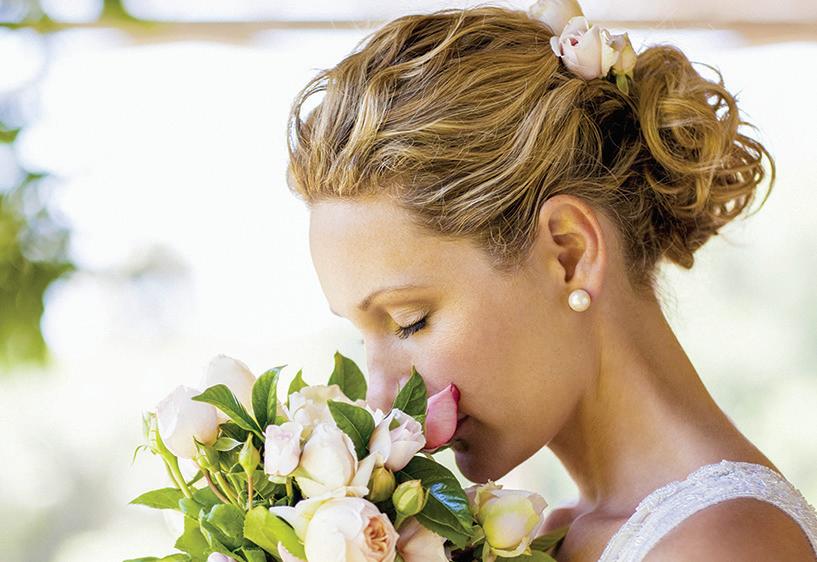
Brides- and grooms-to-be select people who are near and dear to their hearts to be special parts of their momentous days. So the chance to participate in a friend’s or family member’s wedding is a great honor.


A wedding party plays a key role in both the ceremony and reception. Participants do everything from helping couples make decisions to addressing invitations to providing emotional support. As so much is asked of the wedding party — particularly the maid/matron of honor and bridesmaids — it’s customary to bestow gifts on those people who devoted so much time and effort to the wedding. These potential bridesmaid gifts can serve as a thoughtful and unique to way to thank bridesmaids for all that they’ve done.
• Photo books: Gift the bridesmaids with photo books of carefully curated photographs taken throughout the wedding planning experience. Pepper the books with other photos, such as images of you with the bridesmaids at fun moments throughout your lives together.
• Portrait wine or champagne glasses: Beverage glasses customized with the bridesmaids’ likenesses painted or printed onto them make for great gifts. Bridesmaids will enjoy sipping their favorite drinks in special glasses for years to come.
• Personalized phone cases: Who doesn’t rely on their mobile phones these days? Treat your bridesmaids to something special with colorful phone cases with their names embossed or printed on the outsides.
• Wellness or spa gift card: After all of the running around for the wedding, bridesmaids may need a little extra pampering. Gift cards to a local spa can fit the bill.
• Birthstone jewelry: Necklaces, rings or earrings become that much more special when they’re customized to the recipients. Purchase jewelry with your bridesmaids’ birthstones so they’ll be as unique as each woman.
• Friendship bracelets: Gift each bridesmaid with beaded friendship bracelets that features all of the ladies’ initials. Be sure to keep one for yourself, and you all can enjoy nights on the town showcasing your special bracelets.
• Monogrammed robes or purses: A customized pocketbook, robe or another item bridesmaids will use every day can make for an extraspecial item that will serve as a daily reminder of how much you appreciate them.
Bridesmaid gifts are a great way for brides to thank their bridesmaids for all that they’ve done to make a couple’s wedding day special.
Much goes into being photo-ready on your wedding day. After months of planning, the wedding day is the couple’s time to really shine, and many go to extraordinary lengths to look their best. Gowns and tuxes may garner their fair share of attention, but hairstyles also can help couples look their best.

Couples can wear their hair how they see fit, but certain hairstyles have exhibited some serious staying power and can look timeless in photos and videos for years to come.
• Classic low bun or chignon: This is one hairstyle that certainly has withstood the test of time. A bun can be as sleek as a bride desires, or tendrils can be pulled out to frame the face, and the bun can be anything from minimal to messy. Pulling hair back may be more comfortable on warm days and there’s no frizz to worry about if Mother Nature fails to cooperate.
• Vintage curls: Brides whose dresses harken back to a bygone era may want to complement that style with a hairdo that also speaks to that moment in time. For example, the intricate pin curls of the 1920s likely will tie into a gown with an umpire waist.
• Fancy ponytail: Like a bun, a ponytail can pull hair away from the face for comfort and style. It’s a bit less formal than a bun and can be styled in many different fashions, even incorporating braids.
• Side-swept waves: Evoke movie-star drama with a hairstyle that features hair pulled to one side and cascading waves down the length of the face.
• Loose waterfall braids: Carefree boho looks run the gamut of styles. One to consider is loosely plaited waterfall braids that add whimsy. Additional braided options also work well for less formal weddings.
• Half-up, half-down: This hairstyle offers the best of both worlds. It enables the hair to be pulled back on top, and then the bottom is left loose, whether straight or in curls or waves.
• Ballerina top knot: This is a take on the bun. But rather than pinned at the nape, it is high on the crown of the head.
• Short bob or pixie with accents: Shorter hair also can look stunning. A bob or pixie cut can be enhanced with sparkling barrettes or woven-in flowers.
• Halo braid: This braid is fashioned so that it goes over the top of the head and mimics the look of a crown or halo. It may negate the need for a tiara.
Men also have plenty of options to get their hair wedding day-ready. Classic shorter cuts feature close-cut sides and more length on top, which can be spiked, tousled or even slicked back depending on personal preference. However, any length hair is in fashion, and grooms can don buns, ponytails, natural texture, and much more.

